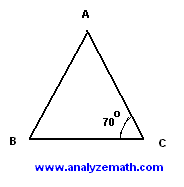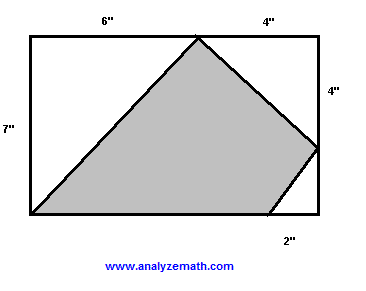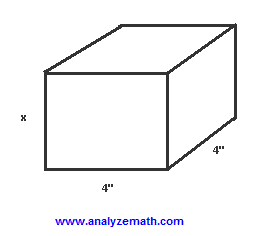ACT MAGIC7
"A Journey Towards a Great Math Score"
Seven sample math problems for the ACT/SAT test given to my students weekly along with my detailed solutions. Take the quizzes, grade your own work, and try not to cheat yourself!
Note: Sometimes there are different ways to solve a math problem, if you got the correct answer using a logical mathematical process then your solution may not look like my examples; however, you are still accurate and on your journey to a fabulous ACT math score. rc

set 1 solutions:
1. C is correct! The domain or independent variable is always x and the range or dependent variable is always y. In an ordered pair (x , y) x is always first. So the correct answer is just a listing of all x elements. If you need a memory device to keep domain and range straight try this.
>> “RAYNGE contains no X.” Yes, I am aware that spelling is not one of my strengths!
2. F is correct! The slope or “rate of change” appears negative so eliminate answers H and J.
(The ACT Test usually has two far out or deliberately misleading answers. I call them garbage answers. If you need to guess, then guessing among two answers is better than guessing from four. Always try to throw out the garbage answers.) Now, we know how to find slope so we don’t need to guess.
Slope (m) has the subtracted Ys on top (numerator ) and the subtracted Xs become the bottom or denominator.
m = rise = y2 - y1
run x2 - x1
Two of the exact points we can see on this line are (0,3) and (3,-3) so 3 - - 3 = 6 = - 2
0 – 3 -3
3. B is correct! “Annual Rate of change” should be a fraction, and means we will have to divide by the number of years. Thus our solution will be
increase or decrease in value = (174900-152400) = 22500/12
years 2010-1998
4. C is correct! Modine makes salary plus commission of 4.5% of sales (d). Per cent is latin and means “out of 100” so to change % to a decimal loose the percent sign and divide by 100. (just move the decimal two space to left.) We need to add a zeros to save the place value and 4.5% becomes 0.045
5. B is correct! Absolute value is defined as the same distance on both sides of zero on our number line. If you have to guess throw out the garbage answers first, and since absolute value requires two answers we can throw out the garbage graphs of A and D. To solve absolute value get the absolute value on one side and the constant (numbers) on the other side of the equation. Then drop the || signs and work two equations one being positive and one negative. |x-3| -4 = 0 becomes |x-3| = 4 so solve x - 3 = 4 and x - 3 = - 4 , thus we need a graph with points at -1 and 7.
6. C is correct! $10.00 – $4.95 = $ 5.05 now divide so at .10 a text she can afford 50 more text so
100 + 50 = 150. The extra nickel gets left out as ½ a text has no meaning in the problem.
7. A is correct! From slope intercept form of a line we have y = mx + b , and we know the slope m is 2.24 and the y-intercept is (0, 16.45) if we change the y-intercept and not the slope our new line must be parallel to the original line. The new y-intercept will be (0 , -3.8). The line will be lower on our graph. If you pull the line down the graph keeping the slope positive and parallel then the x-intercept must get larger. Try it with your pencil on the graph. Place your pencil on the line and move it down keeping it parallel to the line. If the slope had been negative the opposite would have been true. However, problem seven is a great example of why you need to read and then throw out the garbage answers. B can’t be correct as we are decreasing not increasing the y-intercept. C and D can’t be correct because we are not changing the slope at all. |

|
ACT MAGIC7 “A Journey toward a Great Math Score.”
Set 3 rclark
1. In a shipment of televisions, 1/50 of the televisions are defective. What is the ratio of defective to non-defective televisions? a 1/50 b. 2/51 c. 1/49 d. 2/49 |
2.Which of the following is divisible (with no remainder) by 4?
a. 3450056 b. 3345033 c. 3450096 d. 3345017 |
3. A particle travels 1 x 106 meters per second in a straight line for
5 x 10^-6 seconds. How many meters has it traveled?
a. 6 meters b. 5 meters c .5 meters d 5 feet |
4  |
The lengths of sides AB and AC in the triangle below are equal. What is the measure of angle ∠ A
a 30 degrees b 40 degrees
c 50 degrees d 70 degrees |
5.
Simplify and Solve x^2 = (x/2)^2 + (2√3)^2 a 2 b 3 c 4 d 5.5 |
6. If 8y = 3x - 11, then x =
a. 24 y - 33 b 24y - 11 c (3y - 11)/8 d (8y+11)/3 |
7.When graphed in the (x,y) coordinate plane, at what point do the lines 2x + 3y = 5 and x = -2 intersect? a (-2, 3) b (-1,3) c ( -2,-1) d ( -2, -3) |
MY Solutions may not match your , but when your right your right.
1.The answer is C. If 1/50 then is defective then 49/50 are ok. 1 - 1/50 = 49 / 50 are not defective. Ratio means fraction and the first is the numerator and the second denominator. Hence the ratio of defective to non-defective is given by
(1 / 50) / (49 / 50). When you have a fraction over a fraction then you invert bottom fraction and multiply to get (1*50 /50 * 49 )= 1/49 |
2. The answer is A. Four goes into 100 evenly so a whole number is divisible by 4 if the number formed by the last two digits is divisible by 4. The numbers formed by the last two digits of the given numbers are: 33, 56, 69, and 17. The only one that is divisible by 4 is 56. |
3. The answer is B. We are given the speed 1 x 106 m/s and the time 5 x 10-6 seconds. We need to find distance in meters, not feet so throw out answer D. d = rt distance = rate * time d = ( 1 x 106 m/s ) *( 5 x 10-6 s ) = 1 x 106 x 5 x 10-6 = 5 106 + (-6) = 5 100 = 5 meters |
4. The answer is B. Since the lengths of sides AB and AC are equal, then the triangle is isosceles and therefore angles B and C are equal in size. Hence angle A is given by
180 - (70o + 70o) = 40 degrees |
5. The answer is c.
x2 = (x/2)2 + (2√3)2 square everything in each parenthesis. When you square
x2 = x2 / 4 + (4)(3) a square root the radical sign leaves so 3.
multiply all three terms by 4 to get rid of fractions
4 x2 = x2 + (4) (4)( 3) take all x2 to left side
3 x2 = (16)(3) divide both sides by three
x2 = 16 square root both sides and x = 4 |
6. The answer is D. We need to solve for x so x needs to be on one side or the other alone.
8y = 3x – 11 add 11 to both sides 8y + 11 = 3x - 11 + 11
8y + 11 = 3x divide both sides by 3 (8y + 11) / 3 = x
|
7. The answer is A. Graph paper or a graphing calculator would be fast; however, solving the system does not take much longer. We need to solve the following system of equations. 2x + 3y = 5 and x = - 2 Substitute -2 for x in the equation 2x + 3y = 5 and solve for y. 2(-2) + 3y = 5
-4 +3y = 5 3y = 9 y = 3 so (-2, 3) is intersection |
|
ACT MAGIC7 “A Journey Toward a Great Math Score.”
Set 4 rclark
-
Rufus earned $3,200 per month as a teacher for the ten months from September to June. Then he took a job as a barista at a local café, where he earned $2,000 per month during July and August. What was his average monthly pay for the 12 months?
A $2,400 B $2,500 C $2,600 D $2,800 E $3,000
2.
Which of the graphs is the solution set of -3x ≤ 12
|

|
5. The lengths in the rectangle below are in inches. What is the shaded area in square inches?
a
38 b 39
c 67
d 24 |

|
6. What is the average of 7/8 and 3/4?
A 13/ 8 B 13/16 C 10/12 D 21/32
7. A solution is made of water and pure acid. If 75% of the solution is water, how many litters of pure acid are in 20 litters of this solution?
A 9 B 20 C 7 D 5
If you got them some other mathematical, logical way that’s fine, but here are my solutions.
-
E is correct. We have made money of (3200 * 10) + (2000*2) then divide by 12 to get the mean. 36000/12
-
C is correct. Divide both sides of the given inequality by - 3 and flip the inequality symbol because we are multiplying or dividing by a negative. - 3x / - 3 ≤ 12 / - 3 thus x ≥ -4 We need a colored circle at -4 and a line drawn to right.
-
A is correct. We first convert the speed into miles per minute. 66 / 60 = 1.2 miles per minute. Now use the speed and the time to find the distance. 1.2 (miles/minute) * 99 minutes = 108.9 miles.
-
B is correct. Slope = m = rise = y2 - y1 so 3- - 3 = 6/3
run x2 - x1 4 - 1
-
A is correct. The total area of the rectangle is given by {A = bh or lw} 7*(6 + 4) = 70 square inches. The non shaded part of the rectangle is made up of three triangles whose total area is given by
{A = ½ bh} (1/2)*6*7 + (1/2)*4*4 + (1/2)*3*2 = 32 square inches The area of the shaded region is equal to the total area of the rectangle minus the total non-shaded area. Thus 70 - 32 = 38 square inches.
-
B is correct. Average of 7/8 and ¾ = (7/8 + 3/4) / 2 = we need a like denominator so multiply ¾ by 2/2 which gives us (7/8 + 6/8) / 2 = (13 / 8) / 2 so invert and multiply and get = 13 / 16 .
-
D is correct. If 75% of the solution is water then 100% - 75% = 25% is acid.
If the solution is 20 litters, then 25% of 20 = 25% * 20 = 5 litters are pure acid.
|
Set 5 rclark
1.
The total surface area of all six faces of the rectangular box below is equal to 128 square inches. What is x in inches?
A 4 B 6
C 8 D Not enough information |
 |
2. Which of the following is equal to (n– 3)2 if n= 11?
A (n+ 6)(n– 6) B (n+ 5)(n– 7) C (n+ 4)(n– 8) D (n+ 3)(n– 9) E (n+ 2)(n– 10) |
3. A square field has an area of 22,500 square feet. To the nearest foot, what is the diagonal distance across the field?
A 150 feet B 178 feet C 191 feet D 212 feet E 260 feet |
4. Modine wants to fill in two sections of her backyard with sod that must be purchased in 2-x-2-foot squares. If the two sections measure 30 x 40 feet and 60 x 80 feet, how many squares of sod does she need to buy?
A 1,000 B 1,250 C 1,500 D 1,600 E 2,000 |
5. Which of the following equations corresponds the data in the table?
A) y = 1 / ( x + 2) B) y = 2 / ( x + 4) C) y = (x - 1) / ( x + 2)
D) y = 2 / ( x - 2) E) y = 1 / ( 2x + 2) |
X |
-20 |
-10 |
0 |
5 |
20 |
Y |
-1/8 |
-1/3 |
1/2 |
2/9 |
1/12 |
|
6. When you multiply a number by 4 and then subtract 7, the result is the same as if you first subtracted 7 from the same number and then multiplied by 11. What is the number?
A 10 B 13 C 19 D 23 E 31 |
7. Which of the lines below is not parallel to the line 6x - 2y = 10
A 3x - y = 7 B -6x + 2y = 20 C 3x + y = 7 D 6x - 2y = 5 E x - y/3 = 9 |
If you got them right some other way that’s fine, but here are my solutions.
1. B is correct. The total area of the front and back faces is 2(4x) The total area of the left and right faces is given by 2(4x) The total area of the top and bottom faces is given by 2(16) So total surface area of all 6 faces is given by 2(4x) + 2(4x) + 2(16) = 16x + 32 = 128 Solve for x by subtracting 32 and dividing by 16. 16x = 126 or x = 6 |
2. The answer is B. (11– 3)2 = 82 = 64 put 11 into each ( ) until you get 64. A is 16 *5 C is 15*3 D is 14*2 E is 13*2 ; However B is 16 * 4 =64 |
3. The answer is D . First find the sides of the square by taking the square root of 22500 = 150 feet on each side. From the Pythagorean theorem ( 12 +12 = c2)and trigonometry we know that the special 45-45 90 equilateral triangle has ratio dimensions of 1, 1, square root 2. So multiply the square root of 2(about 1.4) times 150. |
4. The correct answer is D. 30 x 40 =1200 and 60 x 80 =4800 1200+4800 = 6000 square feet. The sod comes 2 X 2 or 4 square feet so divide by 4
6000/4 = 1500 square of sod. |
5.The answer is B. The process is called plug-in. We are not working the algebra we are checking five answers by pluging in the simplest values to check equations until you find the winner. I think the easiest value to start with is always 0. So put in 0 for x and see if you come out with ½ for y.
C= -1/2 and D = -1. So next check a,b,c again with another simple value.
(5, 2/9) We find A = 1/7 C= 4/7 Thus B = 2/9 is the winner. |
6.The answer is A. You could do plug-in; however I thought is was quicker to work the equation. 4x-7 = 11(x-7) > 4x -7 = 11x – 77 > 70 = 7x so x = 10 |
7.The answer is C. Line are parallel if they have the same slope. In standard form of Ax +By = C The slope is defined by –A/B. so the slope of our line is -6/-2 or 3. Now do –A/B for the answer choices. Aslope = -3/-1 or 3 Bslope = 6/2 or 3 Cslope = -3/1 or -3 I only need one line not parallel so I skip D and E and go to the next problem. |
|
Sources for above practice questions:
Advanced Mathematical Concepts Pre-Calculus with App. by Glencoe |
Math Course 1 by McDougal Littell |
Algebra 2 by Glencoe McGraw Hill |
Algebra 2 by Houghton Miflin Harcourt |
Geometry by Glencoe McGraw Hill |
Geometry by Houghton Miflin Harcourt |
www. USA Test Prep.com |
www. Standard Test Prep. Com |
Algebra 2 by Prentiss Hall |
|
|
|
|
|
| CrackACT.com |
Khan Academy ACT Overview |
| |
|
|






